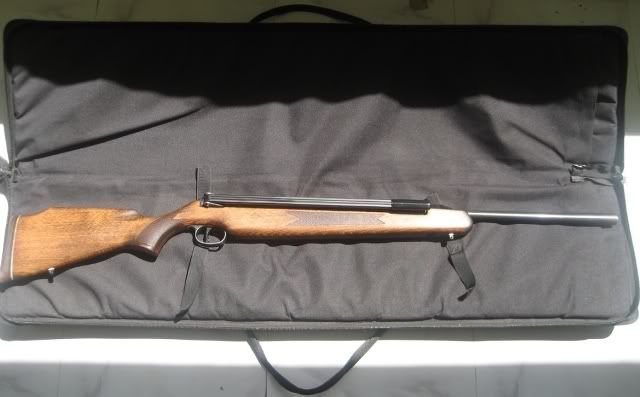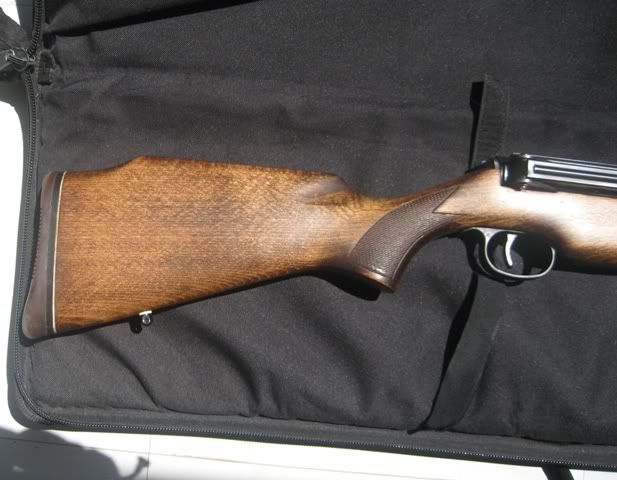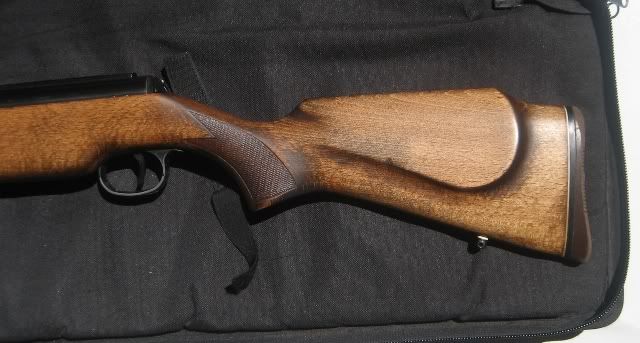How to: Painting your Rifle Stock - Picture Heavy
Posted: Sun Nov 02, 2008 5:36 am
Hi Guys!
I was waiting to get Rusty's feedback on the stock, before putting up the
steps. After all, I don't want you guys to try out something that failed for
me.
Here's a before shot of the gun: (Borrowed from Inder's post)

Notice the buttpad in the following pics:


The barrel that broke my heart with the bluing or lack thereof!

The buttpad needed replacement. But, I took a shortcut that made it match
the rest of the gun. I have placed an order for a buttpad. But may not use it.
Now. On to the procedure.
Before you attempt painting your stock, practice on a cheap stock or some
piece of wood identical to the stock to be painted. Observe how the paint
settles on the wood. Find out the optimum distance to ensure the thinnest,
most consistent coat.
Here's my test stock:

This is where all the testing took place. Holds, distances, hold time etc.
And here's the paint:

Important: The thinner on the pic was NOT used to clean the gun. I bought it
to clean the paint from the adjoining areas if need be. Or to quickly remove
paint from metal parts if something goes wrong. Use SURGICAL SPIRIT to clean
the stock.
Now, to the Diana.
First, separate the stock from the action.

Make sure that you remove all parts from the stock. This includes the
trigger guard, Buttpad, Slings, studs, rails, bipods etc

Make sure all surfaces to be painted are free of dust, dirt, grease etc.
If the stock has any damage, tend to that first.
Rusty has put up a great article on how to effectively accomplish that.
Check to see if the chequering has thinned out anywhere. Use a toothpick or
something similar, try and deepen the chequering if possible. The same
method can be used to remove excessive paint from the chequering. DO NOT apply multiple coats. Multiple coats will thin the chequering. Once you achieve a satisfactory coat, mask it using tape after its dried completely. Its important that you mask it ONLY after its dried thoroughly, else the tape will peel the paint.
Always paint in a well ventilated, dust free area.
DO NOT paint near open flames or where there's a risk of sparks flying. Save
the ciggy for later.
Wear gloves and eye protection.
Make sure everything you need during the job are within easy reach.
Sand the wood properly using the correct grit paper. Rusty can guide you on
that front. Sanding will ensure that the paint sticks to the surface. Else,
though it will appear painted, peeling/chipping may occur. So do it
perfectly. Do not remove too much wood though. Be extra careful of the
chequering.

DO NOT paint in a place where there's risk of tripping over on stuff. Find a
nice, roomy ventilated space.
ALWAYS paint in one direction. This ensures consistency and better finishes.
DO NOT spray sporadically or hold the spray for long onto one particular
area. Use fluid motion. If you miss an area or if its too thin, it will be
covered in the next coat. So dont fret.
Notice how thin the first coat is. The wood can be seen lightly in certain areas and corners. Let it dry thoroughly. The next coat will take care of the light areas.

Shake the can well before each coat.Clean the nozzle after each coat.
Failing to do so will cause partially solidified paint drops to stick to the
painted surface.
Here's after a second coat. The paint is even and darker:

DO NOT inhale the fumes. Take frequent breaks in between. Its good for you
and gives time for the paint to dry.Just remember not to overdo it.
Always hold the spray canister at the greatest possible distance and ensure
thin, even coats. Its always better to get less paint transfer and use
multiple coats for a perfect finish than to hurry it up and have paint
running to develop into bubbles and ugly splotches
Remove excessive paint from the chequering using a toothpick AFTER it has
dried. Mask it and continue with the rest of the coats.
Give ample time for each coat to dry. DO NOT touch to see if its dry.
Depending on the paint, it may take from a couple of hours to a day for the
paint to dry. It also depends on the climate. You get the drift.
After each coat, look for deformities, missed areas etc. Missed areas can be
given a short extra blast and deformities can be sanded to perfection.
ALWAYS be careful not to overdo it.
Here's after the last coat. Notice the even spread and dark matte finish.

While painting, if you find dust or fibres sticking to the paint, DO NOT try
to clean it immediately. The paint has a characteristic adherence that will
cause it to stretch if its cleaned before drying. Most such stickies will
come off once you rub it after the paint has dried.
Here's the trigger guard before the paint

And After:

Here's the breech before sanding, cleaning and rubbing:

And after:

There's more work going into the breech, but later, once I can dismantle the rifle.
Here's prepping the barrel. I used double sided tape to seal off the barrel.

Trim off the ends so that the front end of the barrel weight gets an even
coat.

The photo is for illustration only. Trim the tape before attaching to the
barrel to prevent slipping and damaging the gun / hurting yourself.
Use masking tape for the end that contacts the action. Always cover a large
part as the paint tends to fly onto parts you dont want to coat.
Here's the barrel after 3 coats:

I had to remove the paint from the barrel due to a large scratch, but its
repainted now.
The cocking arm needed attention too. I did not disassemble it from the
action. Instead prepped it so:

Pay attention to the joints and hinges as the paint may obstruct free
movement. Quickly clean off the parts after a coat to make sure they dont
stick. A light coat of spirit on these areas will prevent the paint from
sticking.
Here's the cocking arm - painted and drying.

Now, to the buttpad. Unfortunately I dont have the work in progress pics.
But here's the idea:
The buttpad comprises of three parts:
[1] A white plastic spacer that contacts the stock wood.
[2] A black rubber spacer that contacts the plastic spacer.
[3] A brown thick rubber end that contacts the black spacer.
It takes a bit of work to separate the three components.
I cleaned the black rubber and the white plastic thoroughly to get it back to
its original condition.
Once done, I installed only the white plastic sleeve and the black rubber
part. The end pad was discarded.
The benefits of this are many-fold:
For starters, the unsightly buttpad wont spoil an otherwise attractive
rifle, The scope relief feels better and the hold is also improved since the
overall length is reduced. However except for the looks, all the other
benefits are dependent on shooter preference. What works for me, may not for
you.
The only flipside is that the buttpad cannot be placed on a smooth surface as it will slip since only the screws make contact. However I believe in resting the buttpad on your shoe if need be. Not on the ground.
Anyways, here's the finished buttpad on the finished rifle:


Now for the finished rifle: (Notice the buttpad.)

Some things to keep in mind:
Each coat should be a full coat to maintain consistency.
DO NOT paint the stock in installments as the coats may dry to appear in different shades.
Monitor how the paint responds to different holds, distances etc and use it
to your advantage to perfect the job.
Once all the coats have been completed, give it a couple of days to dry
completely. Paint may appear dry on the outside, but will not completely for
at least 12 hours. Leave it for a few days and then apply the clear.
Once the painting has been completed, give it a couple of coats of clear,
following the same guidelines. Just cause its transparent doesn't mean you
can slack.
If not done properly, Clear coats will ruin all you work. If done properly,
they will preserve and showcase the finish for long.
Wait for a couple of days before reassembling it and shooting.
Hope this helps. Feel free to pop any questions.
Mo.
I was waiting to get Rusty's feedback on the stock, before putting up the
steps. After all, I don't want you guys to try out something that failed for
me.
Here's a before shot of the gun: (Borrowed from Inder's post)

Notice the buttpad in the following pics:


The barrel that broke my heart with the bluing or lack thereof!

The buttpad needed replacement. But, I took a shortcut that made it match
the rest of the gun. I have placed an order for a buttpad. But may not use it.
Now. On to the procedure.
Before you attempt painting your stock, practice on a cheap stock or some
piece of wood identical to the stock to be painted. Observe how the paint
settles on the wood. Find out the optimum distance to ensure the thinnest,
most consistent coat.
Here's my test stock:

This is where all the testing took place. Holds, distances, hold time etc.
And here's the paint:

Important: The thinner on the pic was NOT used to clean the gun. I bought it
to clean the paint from the adjoining areas if need be. Or to quickly remove
paint from metal parts if something goes wrong. Use SURGICAL SPIRIT to clean
the stock.
Now, to the Diana.
First, separate the stock from the action.

Make sure that you remove all parts from the stock. This includes the
trigger guard, Buttpad, Slings, studs, rails, bipods etc

Make sure all surfaces to be painted are free of dust, dirt, grease etc.
If the stock has any damage, tend to that first.
Rusty has put up a great article on how to effectively accomplish that.
Check to see if the chequering has thinned out anywhere. Use a toothpick or
something similar, try and deepen the chequering if possible. The same
method can be used to remove excessive paint from the chequering. DO NOT apply multiple coats. Multiple coats will thin the chequering. Once you achieve a satisfactory coat, mask it using tape after its dried completely. Its important that you mask it ONLY after its dried thoroughly, else the tape will peel the paint.
Always paint in a well ventilated, dust free area.
DO NOT paint near open flames or where there's a risk of sparks flying. Save
the ciggy for later.
Wear gloves and eye protection.
Make sure everything you need during the job are within easy reach.
Sand the wood properly using the correct grit paper. Rusty can guide you on
that front. Sanding will ensure that the paint sticks to the surface. Else,
though it will appear painted, peeling/chipping may occur. So do it
perfectly. Do not remove too much wood though. Be extra careful of the
chequering.

DO NOT paint in a place where there's risk of tripping over on stuff. Find a
nice, roomy ventilated space.
ALWAYS paint in one direction. This ensures consistency and better finishes.
DO NOT spray sporadically or hold the spray for long onto one particular
area. Use fluid motion. If you miss an area or if its too thin, it will be
covered in the next coat. So dont fret.
Notice how thin the first coat is. The wood can be seen lightly in certain areas and corners. Let it dry thoroughly. The next coat will take care of the light areas.

Shake the can well before each coat.Clean the nozzle after each coat.
Failing to do so will cause partially solidified paint drops to stick to the
painted surface.
Here's after a second coat. The paint is even and darker:

DO NOT inhale the fumes. Take frequent breaks in between. Its good for you
and gives time for the paint to dry.Just remember not to overdo it.
Always hold the spray canister at the greatest possible distance and ensure
thin, even coats. Its always better to get less paint transfer and use
multiple coats for a perfect finish than to hurry it up and have paint
running to develop into bubbles and ugly splotches
Remove excessive paint from the chequering using a toothpick AFTER it has
dried. Mask it and continue with the rest of the coats.
Give ample time for each coat to dry. DO NOT touch to see if its dry.
Depending on the paint, it may take from a couple of hours to a day for the
paint to dry. It also depends on the climate. You get the drift.
After each coat, look for deformities, missed areas etc. Missed areas can be
given a short extra blast and deformities can be sanded to perfection.
ALWAYS be careful not to overdo it.
Here's after the last coat. Notice the even spread and dark matte finish.

While painting, if you find dust or fibres sticking to the paint, DO NOT try
to clean it immediately. The paint has a characteristic adherence that will
cause it to stretch if its cleaned before drying. Most such stickies will
come off once you rub it after the paint has dried.
Here's the trigger guard before the paint

And After:

Here's the breech before sanding, cleaning and rubbing:

And after:

There's more work going into the breech, but later, once I can dismantle the rifle.
Here's prepping the barrel. I used double sided tape to seal off the barrel.

Trim off the ends so that the front end of the barrel weight gets an even
coat.

The photo is for illustration only. Trim the tape before attaching to the
barrel to prevent slipping and damaging the gun / hurting yourself.
Use masking tape for the end that contacts the action. Always cover a large
part as the paint tends to fly onto parts you dont want to coat.
Here's the barrel after 3 coats:

I had to remove the paint from the barrel due to a large scratch, but its
repainted now.
The cocking arm needed attention too. I did not disassemble it from the
action. Instead prepped it so:

Pay attention to the joints and hinges as the paint may obstruct free
movement. Quickly clean off the parts after a coat to make sure they dont
stick. A light coat of spirit on these areas will prevent the paint from
sticking.
Here's the cocking arm - painted and drying.

Now, to the buttpad. Unfortunately I dont have the work in progress pics.
But here's the idea:
The buttpad comprises of three parts:
[1] A white plastic spacer that contacts the stock wood.
[2] A black rubber spacer that contacts the plastic spacer.
[3] A brown thick rubber end that contacts the black spacer.
It takes a bit of work to separate the three components.
I cleaned the black rubber and the white plastic thoroughly to get it back to
its original condition.
Once done, I installed only the white plastic sleeve and the black rubber
part. The end pad was discarded.
The benefits of this are many-fold:
For starters, the unsightly buttpad wont spoil an otherwise attractive
rifle, The scope relief feels better and the hold is also improved since the
overall length is reduced. However except for the looks, all the other
benefits are dependent on shooter preference. What works for me, may not for
you.
The only flipside is that the buttpad cannot be placed on a smooth surface as it will slip since only the screws make contact. However I believe in resting the buttpad on your shoe if need be. Not on the ground.
Anyways, here's the finished buttpad on the finished rifle:


Now for the finished rifle: (Notice the buttpad.)

Some things to keep in mind:
Each coat should be a full coat to maintain consistency.
DO NOT paint the stock in installments as the coats may dry to appear in different shades.
Monitor how the paint responds to different holds, distances etc and use it
to your advantage to perfect the job.
Once all the coats have been completed, give it a couple of days to dry
completely. Paint may appear dry on the outside, but will not completely for
at least 12 hours. Leave it for a few days and then apply the clear.
Once the painting has been completed, give it a couple of coats of clear,
following the same guidelines. Just cause its transparent doesn't mean you
can slack.
If not done properly, Clear coats will ruin all you work. If done properly,
they will preserve and showcase the finish for long.
Wait for a couple of days before reassembling it and shooting.
Hope this helps. Feel free to pop any questions.
Mo.